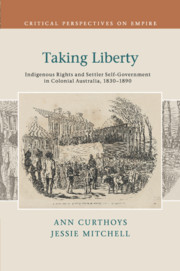Book contents
- Taking Liberty
- Critical Perspectives on Empire
- Taking Liberty
- Copyright page
- Contents
- Abbreviations
- Acknowledgements
- Maps
- Introduction
- Part I A Four-Cornered Contest: British Government, Settlers, Missionaries, and Indigenous Peoples
- 1 Colonialism and Catastrophe, 1830
- 2 ‘Another New World Inviting Our Occupation’
- 3 Settlers Oppose Indigenous Protection, 1837–1842
- 4 A Colonial Conundrum
- 5 Who Will Control the Land? Colonial and Imperial Debates, 1842–1846
- Part II Towards Self-Government
- Part III Self-Governing Colonies and Indigenous People, 1856–c.1870
- Part IV Self-Government for Western Australia
- Conclusion
- Index
2 - ‘Another New World Inviting Our Occupation’
Colonisation and the Beginnings of Humanitarian Intervention, 1831–1837
from Part I - A Four-Cornered Contest: British Government, Settlers, Missionaries, and Indigenous Peoples
Published online by Cambridge University Press: 28 September 2018
- Taking Liberty
- Critical Perspectives on Empire
- Taking Liberty
- Copyright page
- Contents
- Abbreviations
- Acknowledgements
- Maps
- Introduction
- Part I A Four-Cornered Contest: British Government, Settlers, Missionaries, and Indigenous Peoples
- 1 Colonialism and Catastrophe, 1830
- 2 ‘Another New World Inviting Our Occupation’
- 3 Settlers Oppose Indigenous Protection, 1837–1842
- 4 A Colonial Conundrum
- 5 Who Will Control the Land? Colonial and Imperial Debates, 1842–1846
- Part II Towards Self-Government
- Part III Self-Governing Colonies and Indigenous People, 1856–c.1870
- Part IV Self-Government for Western Australia
- Conclusion
- Index
Summary
- Type
- Chapter
- Information
- Taking LibertyIndigenous Rights and Settler Self-Government in Colonial Australia, 1830–1890, pp. 48 - 71Publisher: Cambridge University PressPrint publication year: 2018

